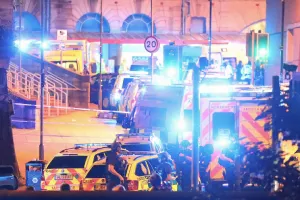First 5 Minutes: Why Response Speed Saves Lives
Why the First 5 Minutes Define Everything
In security incidents, time is unforgiving. Fires can spread in seconds, intruders can vanish before anyone reacts, and violent situations can spiral out of control. For SCR Operators, the first five minutes are the golden window, the opportunity to take control, or risk losing it completely.
UK standards emphasise this urgency. The SIA Standards of Behaviour require proportionate and timely responses, ACS accreditation measures how quickly and effectively incidents are managed, and BSI/NSI codes stress accurate and immediate logging for evidence.
👉 Think of the control room as the brain of the site. If the brain hesitates, the whole body suffers.
Real-World Example: Manchester Arena Bombing (2017)
When the explosion occurred, panic spread instantly. In those first few minutes, thousands of people needed guidance. Control room operators, alongside on-site staff, provided critical CCTV intelligence to emergency services, helped direct evacuation routes, and began securing evidence.
Had there been confusion, silence, or delay, many more lives could have been lost.

Lesson for SCR Operators: The first five minutes are about creating order out of chaos. Even in catastrophic situations, a decisive operator can save lives and preserve evidence that later brings justice.
Snap Decisions Save Time
In an emergency, hesitation is the biggest enemy. Operators sometimes fall into “analysis paralysis”, waiting for certainty before acting. But incidents do not wait.
Key behaviours of fast decision-makers:
Recognise the trigger: Alarm, CCTV, or radio report, act immediately.
Trust your training: Procedures exist so you don’t have to second-guess.
Act first, verify second: It is safer to act on a false alarm than ignore a real one.
Example:
During a late shift, a control room operator noticed smoke on a CCTV feed. Instead of waiting to confirm with a patrol officer, they triggered fire response procedures and contacted the fire service. The fire was contained before spreading.
Tip: Ask yourself: “If I wait two minutes, what’s the worst that could happen?” This mindset keeps you proactive.
The Chain Reaction of Delay
Every second lost multiplies the risks. Delayed action creates a domino effect that makes recovery harder.
People at risk: A delayed evacuation means more injuries or deaths.
Evidence lost: Unmarked CCTV can be overwritten in hours.
Trust broken: Colleagues lose faith in control room reliability.
Compliance breached: Failing to act quickly could breach SIA requirements and put your licence at risk.
Example:
At a logistics warehouse, an operator waited for confirmation before escalating an intruder alarm. By the time officers responded, the thieves had stolen high-value goods and escaped. The client’s trust in the security team was damaged.
Tip: Never let uncertainty freeze you. Escalating early protects both safety and reputation.
Building Muscle Memory Through Drills
Emergency services react quickly not because they are fearless, but because they practise. For SCR Operators, drills and simulations turn procedures into instinct.
Why drills matter:
They make responses automatic under pressure.
They reveal flaws in procedures before real incidents.
They improve teamwork and communication speed.
Example:
A corporate office ran monthly “5-minute drills” for lockdowns. During a real hostile intruder event, operators secured all doors in under 90 seconds. Staff later credited their survival to the control room’s quick actions.
Tip: Run drills for multiple scenarios, fire, intrusion, violence, and medical emergencies. Time yourself. Aim to shave seconds off with each practice.
People Before Process
Policies and checklists are essential, but in those first minutes, saving lives must be your top priority.
Fire: Evacuations come before property protection.
Violence: Stop harm first, then secure evidence.
Suspicious behaviour: Act fast to secure safety, then log for investigation.
Example:
At a retail site, an operator spotted aggressive behaviour on CCTV. Instead of waiting to confirm if it was serious, they immediately radioed for staff intervention. Quick action prevented injury to a shop worker.
Tip: When in doubt, ask: “Does this decision protect people first?” If yes, act.
How to Stay Calm When the Clock is Ticking
Fast response does not mean frantic response. Operators who panic, shout, or give unclear instructions create more danger. Calm authority is what guides others through chaos.
Strategies to stay calm:
Take one deep breath before making announcements.
Use plain, simple words, avoid jargon or codes that the public may not understand.
Give one instruction at a time.
Visualise yourself as the “anchor” holding the situation steady.
Example:
During a power outage in a hospital, a calm operator used radio calls to guide staff to manual evacuation points. Because their tone was steady, staff stayed focused instead of panicking.
Tip: Remember, if you sound calm, people act calm.
Reflection Scenario
You are in the SCR. An intruder alarm goes off at the loading bay. At the same time, CCTV shows a person collapsing in reception.
Which incident should you prioritise first?
How do you delegate so both issues are addressed?
What do you log in the first 60 seconds?
👉 Think: Prioritise life safety, escalate, then manage both in parallel.
Did You Know?
Fires can double in size every 60 seconds (London Fire Brigade).
Survival rates in cardiac arrest drop by 10% for every minute without action (NHS).
In 72% of terror-related incidents in the UK, quick responses in the first 5 minutes reduced casualties (Home Office).
Final Reflection: Your Golden Window
The first five minutes are not just a countdown, they are the moment where everything hangs in the balance. Your speed sets the pace, your clarity shapes the response, and your calm keeps chaos under control. In that golden window, you are not just an operator behind screens, you are the guardian of lives, property, and trust.
Takeaway: Own the first five minutes. Train until fast responses feel natural, make clear decisions without hesitation, and lead with calm authority. Remember, when the pressure is highest and the seconds are slipping away, it is your actions that draw the line between safety and disaster.

